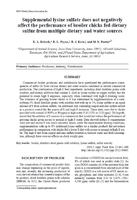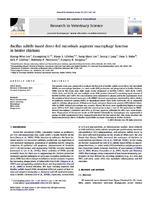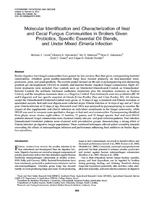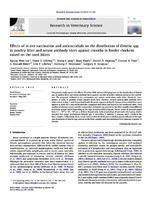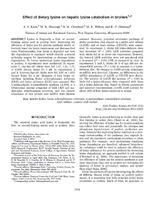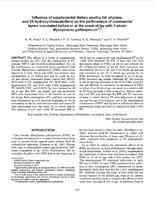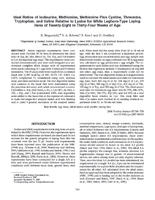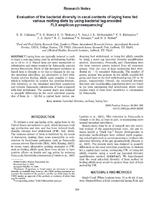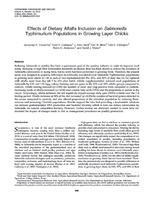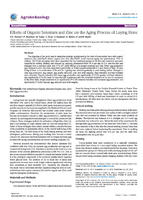Items from "Poultry Nutrition": 30
Supplemental lysine sulfate does not negatively affect performance of broiler chicks fed dietary sulfur from multiple dietary and water sources
Commercial producers and nutritionists have questioned the performance consequences of sulfur (S) from various dietary and water sources combined in current commercial production. The combination of high S containing feed ingredients, including dried distiller’s grains with solubles (DDGS) and dietary additives that contain S such as lysine sulfate…
Bacillus subtilis-based direct-fed microbials augment macrophage function in broiler chickens
The present study was conducted to evaluate the function of Bacillus subtilis-based direct-fed microbials (DFMs) on macrophage functions, i.e., nitric oxide (NO) production and phagocytosis in broiler chickens. DFMs used in this study were eight single strains designated as Bs2084, LSSAO1, 3AP4, Bs18, 15AP4, 22CP1, Bs27, and Bs278, and one multiple…
Molecular identification and characterization of ileal and cecal fungus communities in broilers given probiotics, specific essential oil blends, and under mixed Eimeria infection
Broiler digestive tract fungal communities have gained far less scrutiny than that given corresponding bacterial communities. Attention given poultry-associated fungi have focused primarily on feed-associated toxinproducers, yeast, and yeast products. The current project focused on the use of pyrosequencing and denaturing gradient gel…
Effects of in ovo vaccination and anticoccidials on the distribution of Eimeria spp. in poultry litter and serum antibody titers against coccidia in broiler chickens raised on the used litters
The present study reports the effects of various field anticoccidial programs on the distribution of Eimeria spp. in poultry litter and serum antibody titers against coccidia in broiler chickens raised on the used litters. The programs included in ovo vaccination and various medications with either chemicals, ionophores, or both. In general, serum…
Effect of dietary lysine on hepatic lysine catabolism in broilers
Lysine is frequently a first- or second-limiting amino acid in poultry diets. Improving the efficiency of lysine use for protein synthesis would effectively lower the lysine requirement and decrease feed costs. Understanding how lysine is degraded and how the degradation is regulated would identify potential molecular targets for interventions to…
Influence of supplemental dietary poultry fat, phytase, and 25-hydroxycholecalciferol on the performance of commercial layers inoculated before or at the onset of lay with F-strain Mycoplasma gallisepticum
The effects of 2 levels of supplemental dietary poultry fat (PF) and the combination of PF, phytase (PHY), and 25-hydroxycholecalciferol (D(3)) on the performance of commercial layers inoculated with F-strain Mycoplasma gallisepticum (FMG) were investigated in 2 trials. Sham and FMG inoculations were administered at 12 (before lay) and 22 (early in…
Ideal Ratios of Isoleucine, Methionine, Methionine Plus Cystine, Threonine, Tryptophan, and Valine Relative to Lysine for White Leghorn-Type Laying Hens of Twenty-Eight to Thirty-Four Weeks of Age
Seven separate experiments were conducted with Hy-Line W-36 hens to determine the ideal ratio of Arg, Ile, Met, Met+Cys, Thr, Trp, and Val relative to Lys for maximal egg mass. The experiments were conducted simultaneously and were each designed as a randomized complete block design with 60 experimental units (each consisting of 1 cage with 2 hens)…
Evaluation of the bacterial diversity in cecal contents of laying hens fed various molting diets by using bacterial tag-encoded FLX amplicon pyrosequencing
Laying hens are typically induced to molt to begin a new egg-laying cycle by withdrawing feed for up to 12 to 14 d. Fasted hens are more susceptible to colonization and tissue invasion by Salmonella enterica serovar Enteritidis. Much of this increased incidence in fasted hens is thought to be due to changes in the native intestinal microflora. An…
Effects of dietary alfalfa inclusion on Salmonella Typhimurium populations in growing layer chicks
Reducing Salmonella in poultry has been a paramount goal of the poultry industry in order to improve food safety. Inclusion of high-fiber fermentable feedstuffs in chicken diets has been shown to reduce the incidence of Salmonella colonization in laying hens, but no work has been performed in growing birds. Therefore, the present study was…
Effects of organic selenium and zinc on the aging process of laying hens
The objective of the study was to determine whether supplementing the diets of post-molted hens with organic selenium (Se) (Sel-Plex®) and/or organic Zinc (Zn) (Bio-Plex®)1 could improve laying hen performance. Prior to molting, 120-78 wk old laying hens were separated into four treatment groups of 30 hens per treatment and were subjected to…
 An official website of the United States government.
An official website of the United States government.


